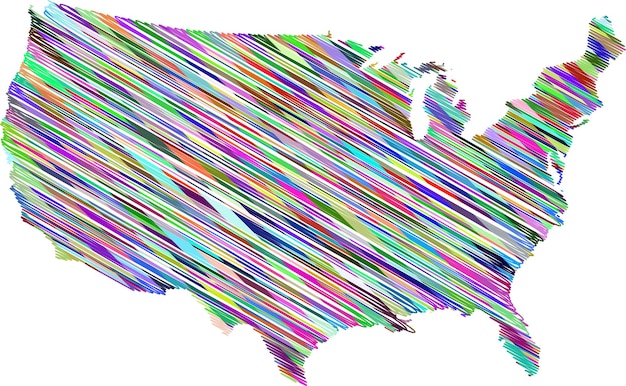Analyzing the Impact of Gerrymandering on Voting Rights: A 2025 Update

Analyzing the Impact of Gerrymandering on Voting Rights and Political Representation: A 2025 Update reveals how manipulating district boundaries affects fair elections and equal representation in the US, potentially diluting minority votes and skewing political power.
Gerrymandering, the practice of drawing electoral district boundaries to favor one political party over another, has been a contentious issue in the United States for centuries. As we approach 2025, it’s crucial to re-examine the ways in which this practice continues to shape our political landscape.
This article delves into analyzing the impact of gerrymandering on voting rights and political representation: a 2025 update, highlighting its potential to undermine the principles of fair and equal representation for all citizens. Is gerrymandering truly a threat to democracy, and what can be done to mitigate its effects?
Understanding Gerrymandering: A 2025 Perspective
Gerrymandering, at its core, is the strategic manipulation of electoral district boundaries. This practice aims to create districts that heavily favor one political party or demographic group, often at the expense of fair representation for others. In 2025, with advanced data analytics and mapping technologies, the precision and potential impact of gerrymandering have significantly increased, raising serious concerns about its effects on voting rights and political representation.
Historical Context and Evolution
The term “gerrymandering” dates back to 1812, when Massachusetts Governor Elbridge Gerry approved a district map that critics said resembled a salamander. Since then, the practice has evolved, becoming more sophisticated with the advent of technology. While historically, gerrymandering was often a tool used to consolidate power by incumbent politicians, today, sophisticated algorithms and data analysis allow political strategists to draw district lines with unprecedented precision.
Types of Gerrymandering
There are two primary techniques used in gerrymandering:
- Cracking: This involves diluting the voting power of the opposing party by spreading its supporters across multiple districts, preventing them from forming a majority in any one district.
- Packing: This involves concentrating the opposing party’s supporters into a single district to reduce their influence in other districts.
In both cases, the goal is to minimize the opposing party’s ability to win elections and maintain or increase the majority party’s influence. Such tactics raise serious questions when analyzing the impact of gerrymandering on voting rights and political representation: a 2025 update.
The ongoing debate surrounding gerrymandering underscores the need for vigilance and reform to ensure that the principles of representative democracy are upheld. As the tools and techniques used in gerrymandering become more advanced, the importance of addressing its potential impact on voting rights and political representation becomes even more critical.
The Impact of Gerrymandering on Voting Rights
One of the most significant consequences of gerrymandering is its potential to suppress voting rights. By manipulating district lines, strategically, political parties can dilute the voting power of specific demographics or political affiliations. In 2025, the impact of such tactics is more keenly felt than ever, as they contribute to voter disenfranchisement and skew political outcomes.
Disenfranchisement of Minority Voters
Gerrymandering has the potential to dilute the voting power of racial and ethnic minorities. By strategically drawing district lines, politicians can divide minority communities across multiple districts, preventing them from achieving a majority in any one district. This can lead to reduced representation and limited influence in political decision-making.
Skewed Election Outcomes
The effects of gerrymandering extend beyond just minority voters. By creating safe districts for one party or the other, gerrymandering can lead to skewed election outcomes, where the popular vote does not align with the actual representation in government. This can result in a political system that is unresponsive to the needs and desires of the electorate.
Reduced Political Competition
Gerrymandered districts often lack meaningful political competition, as one party or the other has a significant advantage. This can lead to complacency among elected officials and a lack of responsiveness to the needs of their constituents. When districts are drawn to protect incumbents, there is less incentive for politicians to engage with their communities and address their concerns.

Through analyzing the impact of gerrymandering on voting rights and political representation: a 2025 update, it is clear that it poses a significant threat to democratic principles. By disenfranchising voters, skewing election outcomes, and reducing political competition, gerrymandering can undermine the very foundations of a fair and representative government.
Political Representation and Gerrymandering
Gerrymandering not only affects voting rights but also significantly impacts political representation. Distorted district boundaries can lead to skewed representation in legislative bodies, where the composition does not accurately reflect the will of the voters. Reassessing analyzing the impact of gerrymandering on voting rights and political representation: a 2025 update, is essential to determine the extent of political distortion.
Distorted Representation in Legislative Bodies
Gerrymandering tends to create safe seats for incumbents, which reduces the incentive for politicians to be accountable to their constituents. When elected officials are virtually guaranteed re-election due to the way district lines are drawn, they may become less responsive to the needs and concerns of the people they represent. This can lead to political gridlock and a lack of progress on critical issues.
Erosion of Public Trust
When voters perceive that the electoral system is rigged or unfair, it can erode public trust in government and democratic institutions. Gerrymandering can create a sense of disillusionment and cynicism among voters, leading to decreased participation in elections and a general distrust of politicians and the political process. This erosion of public trust can have far-reaching consequences for the health and stability of democracy.
Impact on Policy Outcomes
Gerrymandering can also affect policy outcomes by creating legislative bodies that are more ideologically polarized. When districts are drawn to favor one party or the other, it can lead to the election of politicians who are more extreme in their views and less willing to compromise. This can make it more difficult to find common ground on important issues and can lead to policy outcomes that are not in the best interests of the public.
Ultimately, the impact of gerrymandering extends far beyond just the drawing of district lines. It affects the fairness and integrity of elections, the responsiveness of elected officials, and the overall health of democracy. That’s why analyzing the impact of gerrymandering on voting rights and political representation: a 2025 update, is crucial for understanding and addressing its harmful effects.
Reform Efforts and Legal Challenges
In response to the pervasive issues caused by gerrymandering, numerous reform efforts and legal challenges have been launched across the United States. States are exploring different methods to redraw district lines fairly, and courts are increasingly scrutinizing gerrymandered maps. Understanding these initiatives is key to analyzing the impact of gerrymandering on voting rights and political representation: a 2025 update.
Independent Redistricting Commissions
One popular reform is the creation of independent redistricting commissions. These commissions are designed to take the power of drawing district lines out of the hands of politicians and give it to non-partisan experts. The goal is to create districts that are more compact, contiguous, and respectful of community boundaries, as well as promoting fairer political competition.
Legal Challenges and Supreme Court Rulings
Over the years, numerous legal challenges have been brought against gerrymandered districts, arguing that they violate the principles of equal protection and free speech. While the Supreme Court has acknowledged the problem of partisan gerrymandering, it has yet to establish a clear legal standard for determining when a district map is unconstitutional. This has made it difficult to successfully challenge gerrymandered maps in court.
The Role of Technology and Data Analysis
- Improved mapping techniques: Allow for more precise and transparent redistricting.
- Data-driven analysis: Help identify and counteract gerrymandering practices.
- Public awareness tools: Educated voters on the impacts of skewed district lines.
These reforms and challenges represent important steps towards addressing the issue of gerrymandering and promoting fairer and more representative elections. While the fight against gerrymandering is far from over, these efforts offer hope for a more democratic future. As we get closer to 2025, continued reform and vigilance is critical. Successfully analyzing the impact of gerrymandering on voting rights and political representation: a 2025 update, depends on the continued evaluation and reform of political policies governing voting laws at the state and federal level.

The Future of Gerrymandering in the United States
Looking ahead, the future of gerrymandering in the United States remains uncertain. While reform efforts have gained momentum in recent years, political parties continue to exploit gerrymandering to gain an advantage in elections. Understanding these dynamics is vital for analyzing the impact of gerrymandering on voting rights and political representation: a 2025 update.
Potential for Further Reform
Despite the challenges, there is still potential for further reform in the fight against gerrymandering. The growing awareness of the issue among voters, coupled with the increasing availability of data and technology, could create new opportunities for promoting fairer and more representative elections.
Ongoing Political Battles
The fight against gerrymandering is likely to remain a contentious battle in the years to come. Political parties will continue to seek ways to gain an advantage through the drawing of district lines, and legal challenges to gerrymandered maps will continue to be filed. The outcome of these battles will have a significant impact on the future of democracy in the United States.
The Importance of Civic Engagement
If voters want to see an end to gerrymandering, it is important that they make their voices heard. One way to do this is by supporting organizations that are working to promote redistricting reform. Another way is by contacting elected officials and letting them know that they care about this issue. By getting involved in the political process, American voters can help create a more level playing field in elections and ensure that everyone has an equal voice.
The road ahead is filled with challenges, success in analyzing the impact of gerrymandering on voting rights and political representation: a 2025 update will rely on the steadfast commitment of reformers, activists, and engaged citizens. Only through continued vigilance and action can people work towards a political landscape where the principles of fair representation and equal opportunity prevail.
Conclusion
In conclusion, gerrymandering remains a significant threat to democracy. Its effects are far-reaching, impacting voting rights, political representation, and the overall fairness of elections. That’s why analyzing the impact of gerrymandering on voting rights and political representation: a 2025 update, is an essential step in preserving these rights.
As we move closer to 2025, it is critical to continue these reform efforts and ensure that every American has an equal voice in their government. By promoting fairer and more representative elections, we can help build a stronger and more vibrant democracy for future generations.
| Key Point | Brief Description |
|---|---|
| 🗳️ Voting Rights | Gerrymandering can dilute minority voting power through district manipulation. |
| 📊 Representation | Districts may not reflect voters, impacting policies and trust in government. |
| ⚖️ Legal Challenges | Efforts include independent commissions and court fights over unfair districts. |
| 🚀 Future Impact | The future depends on civic engagement and continued reform efforts. |
Frequently Asked Questions
Gerrymandering is the manipulation of electoral district boundaries for political gain, undermining fair representation and voter power, and skewing election results. It affects democracy’s integrity.
Gerrymandering can dilute the voting power of minority communities by spreading them across multiple districts or packing them into a single district, reducing their overall influence.
Solutions include independent redistricting commissions, which take the power of drawing district lines out of the hands of politicians, and legal challenges to unconstitutional maps.
Yes, improved mapping techniques, data-driven analysis, and public awareness tools can help identify and counteract gerrymandering practices. Technology also makes gerrymandering easier.
Support organizations focused on redistricting reform, contact elected officials, and stay informed and engaged in the political process to advocate for fair maps and equal representation.
Conclusion
In conclusion, gerrymandering remains a significant threat to democracy. Its effects are far-reaching, impacting voting rights, political representation, and the overall fairness of elections. Analyzing the impact of gerrymandering on voting rights and political representation: a 2025 update is an essential step in preserving these rights.
As we move closer to 2025, it is critical to continue these reform efforts and ensure that every American has an equal voice in their government. By promoting fairer and more representative elections, we can help build a stronger and more vibrant democracy for future generations.





